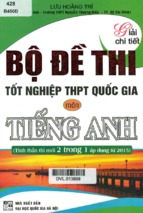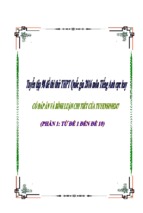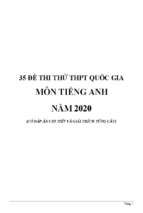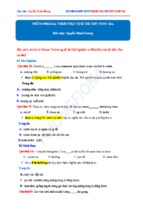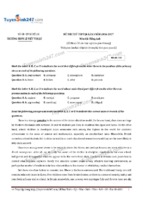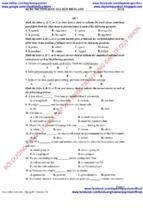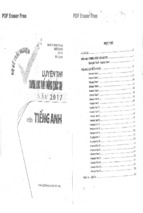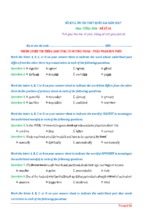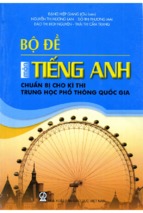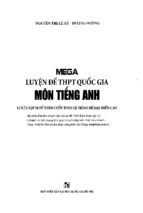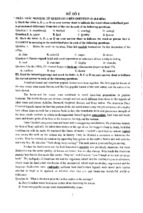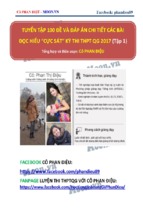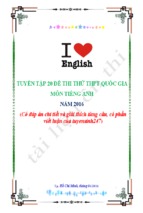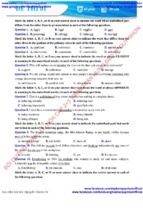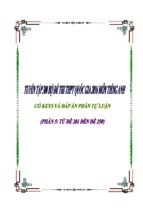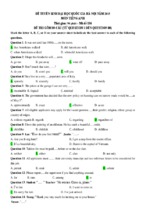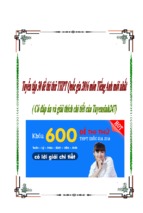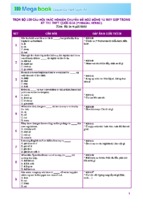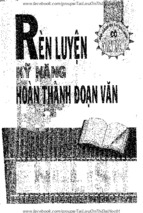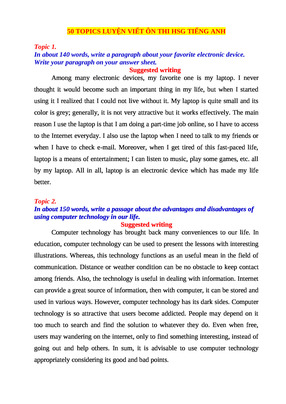Mục lục
Nhà sách Lovebook
MỤC LỤC
PHẦN I: 30 ĐỀ MINH HỌA THEO CHUẨN CẤU TRÚC BGD (24/01/2018) ............................ 09
Đề số 1 ........................................................................................................................................ 9
Đề số 2 ...................................................................................................................................... 24
Đề số 3 ...................................................................................................................................... 40
Đề số 4 ...................................................................................................................................... 55
Đề số 5 ...................................................................................................................................... 71
Đề số 6 ...................................................................................................................................... 87
Đề số 7 .................................................................................................................................... 103
Đề số 8 .................................................................................................................................... 118
Đề số 9 .................................................................................................................................... 132
Đề số 10 .................................................................................................................................. 146
Đề số 11 .................................................................................................................................. 161
Đề số 12 .................................................................................................................................. 175
Đề số 13 .................................................................................................................................. 192
Đề số 14 .................................................................................................................................. 207
Đề số 15 .................................................................................................................................. 226
Đề số 16 .................................................................................................................................. 245
Đề số 17 .................................................................................................................................. 261
Đề số 18 .................................................................................................................................. 276
Đề số 19 .................................................................................................................................. 292
Đề số 20 .................................................................................................................................. 309
Đề số 21 .................................................................................................................................. 327
Đề số 22 .................................................................................................................................. 332
Đề số 23 .................................................................................................................................. 337
Đề số 24 .................................................................................................................................. 342
Đề số 25 .................................................................................................................................. 347
Đề số 26 .................................................................................................................................. 352
Đề số 27 .................................................................................................................................. 357
Đề số 28 .................................................................................................................................. 362
Đề số 29 .................................................................................................................................. 367
Đề số 30 .................................................................................................................................. 373
PHẦN II: MỘT SỐ CẤU TRÚC THÔNG DỤNG ....................................................................378
PHẦN III: CỤM ĐỘNG TỪ THÔNG DỤNG ........................................................................392
Công phá đề thi THPT quốc gia 2018 môn Tiếng Anh
More than a book
PHẦN I: 30 ĐỀ MINH HỌA THEO CẤU TRÚC CỦA BGD
Toàn bộ 30 đề ở phần I đều được soạn theo cấu trúc của Đề Minh Họa do BGD phát hành ngày 24/01/2018.
Từ đề 1-20, chúng tôi cung cấp đầy đủ đáp án chi tiết và nhắc lại đầy đủ những kiến thức cần thiết nhất để tạo nền
tảng vững chắc cho các em. Từ đề 20 -30, chúng tôi sẽ gửi đáp án chi tiết qua Email trong tháng 5 và nửa đầu
thấng 9. Quý thầy cô và các em vui lòng khai báo sách chính hãng tại để nhận được đầy đủ Đáp án chi tiết của 10
đề cuối cùng: congphaanh.com. Xin chân thành cảm ơn!
ĐỀ SỐ 1
“The journey of a thousand miles begins with a single step.”
― Lao Tzu―
Mark the letter A, B, C, or D on your answer sheet to indicate the word(s) OPPOSITE in meaning to
the underlined word(s) in each of the following questions.
Question 1: Henry has found a temporary job in a factory.
A. eternal
B. genuine
C. permanent
D. satisfactory
Question 2: We had a whale of time as everything was quite fantastic.
A. had little time to play
B. had a lot of time to play
C. felt happy
D. felt disappointed
Mark the letter A, B, C, or D on your answer sheet to indicate the word that differs from the other
three in the position of primary stress in each of the following questions.
Question 3: A. equip
B. vacant
C. secure
D. oblige
Question 4: A. effectiveness
B. accountancy
C. satisfaction
D. appropriate
Mark the letter A, B, C, or D on your answer sheet to indicate the word whose underlined part differs
from the other three in pronunciation in each of the following questions.
Question 5: A. decides
B. combines
C. lives
D. appoints
Question 6: A. picture
B. culture
C. pure
D. nature
Mark the letter A, B, C, or D on your answer sheet to indicate the correct answer to each of the
following questions.
Question 7: Mario has now _______ to the point where his English is almost fluent.
A. arrived
B. approached
C. advanced
D. reached
Question 8: It seems that he is having a lot of difficulties, _______?
A. doesn’t it
B. isn’t it
C. isn’t he
D. doesn’t he
Question 9: If energy _______inexpensive and unlimited, many things in the world would be different.
A. is
B. will be
C. were
D. would be
Question 10: Opera singer Maria Callas was known for her _______, powerful voice.
A. intensity
B. intensify
C. intense
D. intensely
Question 11: _______, he would have been able to pass the exam.
A. Studying more
B. Had he studied more
C. If he studied more
D. If he were studying more
Question 12: Dr. Parker gave my mom a lovely _______ for spaghetti carbonara.
A. recipe
B. prescription
C. receipt
D. paper
Question 13: My sunburnt nose made me feel rather _______ for the first few days of the holiday.
A. self-confident
B. self-centered
C. self-conscious
D. self-evident
Question 14: Why is he always _______ the subject of money?
A. bringing up
B. taking up
C. looking up
D. turning up
LOVEBOOK.VN| 9
Đề số 1
Nhà sách Lovebook
Question 15: _______ that she burst into tears.
A. So angry was she
B. Such her anger
C. She was so anger
D. Her anger was so
Question 16: We regret to tell you that the materials you ordered are _______.
A. out of reach
B. out of practice
C. out of stock
D. out of work
Question 17: Do you remember Daisy? I ran _______ her at the Fair yesterday.
A. by
B. down
C. across
D. in
Question 18: It is not _______ to be drunk in the street.
A. respecting
B. respectably
C. respectful
D. respectable
Question 19: A salesgirl is talking to a customer in a clothes shop.
Salesgirl: “Can I help you, madam?”
Customer: “_______”
A. Yes, it's in our summer sale.
B. It's very cheap.
C. No, thanks. I'm just looking.
D. Right. It looks a bit small.
Question 20: Cairo and Roma are talking in the living room.
Cairo: “_______?”
Roma: “I’d rather you didn’t, if you don’t mind.”
A. Would you do me a favour
B. Would you mind if I opened the door
C. Will you please open the window
D. Do you mind helping me with my work
Mark the letter A, B, C or D on your answer sheet to indicate the underlined part that needs correction
in each of the following questions.
Question 21: The woman is famous not only for her beauty, intelligent but also for her hardworking.
A
B
C
D
Question 22: Among the world’s 44 richest countries, there has been not war since 1945.
A
B
C
D
Question 23: What we know about certain diseases are still not sufficient to prevent them from spreading
A
B
C
easily among the population.
D
Mark the letter A, B, C or D on your answer sheet to indicate the word(s) CLOSEST in meaning to the
underlined word(s) in each of the following questions.
Question 24: The lost hikers stayed alive by eating wild berries and drinking spring water.
A. revived
B. surprised
C. connived
D. survived
Question 25: Father has lost his job, so we’ll have to tighten our belt to avoid getting into debt.
A. earn money
B. save money
C. sit still
D. economize
Read the following passage and mark the letter A, B, C, or D on your answer sheet to indicate the
correct answer to each of the questions.
The modern comic strip started out as ammunition in a newspaper war between giants of the
American press in the late nineteenth century. The first full-color comic strip appeared in January 1894 in
the New York World, owned by Joseph Pulitzer. The first regular weekly full-color comic supplement,
similar to today’s Sunday funnies, appeared two years later, in William Randolph Hearst’s rival New
York paper, the Morning Journal.
Both were immensely popular and publishers realized that supplementing the news with comic
relief boosted the sale of papers. The Morning Journal started another feature in 1896, the “Yellow Kid”,
the first continuous comic character in the United States, whose creator, Richard Outcault, had been lured
away from the World by the ambitious Hearst. The “Yellow Kid” was in many ways a pioneer. Its comic
dialogue was the strictly urban farce that came to characterize later strips, and it introduced the speech
balloon inside the strip, usually placed above the characters’ heads.
LOVEBOOK.VN| 10
Công phá đề thi THPT quốc gia 2018 môn Tiếng Anh
More than a book
The first strip to incorporate all the elements of later comics was Rudolph Dirks’s “Katzenjammer
Kids”, based on Wilhelm Busch’s Max and Moritz, a European satire of the nineteenth century. The
“Kids” strip, first published in 1897, served as the prototype for future American strips. It contained not
only speech balloons, but a continuous cast of characters, and was divided into small regular panels that
did away with the larger panoramic scenes of earlier comics.
Newspaper syndication played a major role in spreading the popularity of comic strips throughout
the country. Though weekly colored comics came first, daily black-and-white strips were not far behind.
The first appeared in the Chicago American in 1904. It was followed by many imitators, and by 1915
black-and-white comic strips had become a staple of daily newspapers around the country.
Question 26: In what order does the author discuss various comic strips in the passage?
A. In the order in which they were created.
B. From most popular to least popular.
C. According to the newspaper in which they appeared.
D. In alphabetical order by title.
Question 27: According to the passage, the “Yellow Kid” was the first comic strip to do all of the
following EXCEPT _______.
A. feature the same character in each episode
B. include dialogue inside a balloon
C. appear in a Chicago newspaper
D. characterize city life in a humorous way
Question 28: The word “incorporate” in paragraph 3 is closest in meaning to _______.
A. combine
B. mention
C. create
D. affect
Question 29: Why does the author mention Joseph Pulitzer and William Randolph Hearst?
A. Their comic strips are still published today.
B. They owned major competitive newspapers.
C. They established New York’s first newspaper.
D. They published comic strips about the newspaper war.
Question 30: The word “it” in paragraph 2 refers to _______.
A. balloon
B. farce
C. dialogue
D. the “Yellow Kid”
Question 31: The passage suggests that comic strips were popular for which of the following reasons?
A. Readers enjoyed the unusual drawings.
B. They were about real-life situations.
C. Readers could identify with the characters.
D. They provided a break from serious news stories.
Question 32: What does the passage mainly discuss?
A. The differences between early and modern comic strips.
B. Features of early comic strips in the United States.
C. The effects of newspapers on comic strip stories.
D. A comparison of two popular comic strips.
Read the following passage and mark the letter A, B, C, or D on your answer sheet to indicate the
correct word or phrase that best fits each of the numbered blanks.
Mobile phones emit microwave radio emissions. Researchers are questioning whether exposure to
these radio waves might (33) _______ to brain cancer. So far, the data are not conclusive. The scientific
evidence does not enable us to say with certainly that mobile phones are categorically (34) _______. On
the other hand, current research has not yet proved clear adverse effect associated with the prolonged use
of mobile phones.
Numerous studies are now going (35) _______ in various countries. Some of the results are
contradictory but others have shown an association between mobile phone use and cancer. (36) _______,
these studies are preliminary and the issue needs further, long - term investigation.
LOVEBOOK.VN| 11
Đề số 1
Nhà sách Lovebook
Until the scientific data is more definite, it is prudent for people to try not to use mobile phone for
long periods of time. Don't think that hands free phones are any safer either. At the moment, research is in
fact showing the opposite and they may be just as dangerous. It is also thought that young people
(37)_______ bodies are still growing may be at particular risk.
Question 33: A. bring
B. lead
C. cause
D. produce
Question 34: A. risky
B. unhealthy
C. secure
D. safe
Question 35: A. on
B. by
C. through
D. about
Additionally
However
While
Question 36: A.
B.
C.
D. Though
Question 37: A. whose
B. that
C. with
D. as
Read the following passage and mark the letter A, B, C, or D on your answer sheet to indicate the
correct answer to each of the questions.
Butterflies are among the most extensively studied insects - an estimated 90 percent of the world's
species have scientific names. As a consequence, they are perhaps the best group of insects for examining
patterns of terrestrial biotic diversity and distribution. Butterflies also have a favorable image with the
general public. Hence, they are an excellent group for communicating information on science and
conservation issues such as diversity.
Perhaps the aspect of butterfly diversity that has received the most attention over the past century is
the striking difference in species richness between tropical and temperate regions.
For example, in 1875 one biologist pointed out the diversity of butterflies in the Amazon when he
mentioned that about 700 species were found within an hour's walk, whereas the total number found on
the British islands did not exceed 66, and the whole of Europe supported only 321. This early comparison
of tropical and temperate butterfly richness has been well confirmed.
A general theory of diversity would have to predict not only this difference between temperate and
tropical zones, but also patterns within each region, and how these patterns vary among different animal
and plant groups. However, for butterflies, variation of species richness within temperate or tropical
regions, rather than between them, is poorly understood. Indeed, comparisons of numbers of species
among the Amazon basin, tropical Asia, and Africa are still mostly "personal communication" citations,
even for vertebrates, In other words, unlike comparison between temperate and tropical areas, these
patterns are still in the documentation phase.
In documenting geographical variation in butterfly diversity, some arbitrary, practical decisions are
made. Diversity, number of species, and species richness are used synonymously; little is known about
the evenness of butterfly distribution. The New World butterflies make up the preponderance of
examples because they are the most familiar species. It is hoped that by focusing on them, the errors
generated by imperfect and incomplete taxonomy will be minimized.
Question 38: The word “striking” in paragraph 2 is closest in meaning to _______.
A. physical
B. confusing
C. noticeable
D. successful
Question 39: Butterflies are a good example for communicating information about conservation issues
because they _______.
A. are simple in structure
B. have been given scientific names
C. are viewed positively by people
D. are found mainly in temperate climates
Question 40: The word “exceed” in paragraph 3 is closest in meaning to _______.
A. locate
B. allow
C. go beyond
D. come close to
Question 41: Which of the following is NOT well understood by biologists?
A. European butterfly habitats.
B. Differences in species richness between temperate and tropical regions.
C. Differences in species richness within a temperate or a tropical region.
D. Comparisons of behavior patterns of butterflies and certain animal groups.
LOVEBOOK.VN| 12
Công phá đề thi THPT quốc gia 2018 môn Tiếng Anh
More than a book
Question 42: All of the followings are mentioned as being important parts of a general theory of diversity
EXCEPT_______.
A. differences between temperate and tropical zones
B. patterns of distribution of species in each region
C. migration among temperate and tropical zones
D. variation of patterns of distribution of species among different animals and plants
Question 43: Which aspect of butterflies does the passage mainly discuss?
A. Their physical characteristics
B. Their adaptation to different habitats
C. Their names
D. Their variety
Question 44: The word “they” in paragraph 1 refer to _______.
A. insects
B. butterflies
C. patterns
D. issues
Question 45: The idea “little is known about the evenness of butterfly distribution” in paragraph 5 is
that _______.
A. there are many other things that we don't know about butterfly evenness distribution
B. we don't know anything about butterfly evenness distribution
C. we know much about butterfly evenness distribution
D. we know about butterfly evenness distribution to some extent
Mark the letter A, B, C, or D on your answer sheet to indicate the sentence that best combines each
pair of sentences in the following questions.
Question 46: John was not here yesterday. Perhaps he was ill.
A. John needn't be here yesterday because he was ill.
B. Because of his illness, John shouldn't have been here yesterday.
C. John might have been ill yesterday, so he was not here.
D. John must have been ill yesterday, so he was not here.
Question 47: "Cigarette?", he said. "No, thanks.", I said.
A. He asked for a cigarette, and I immediately refused.
B. He mentioned a cigarette, so I thanked him.
C. He offered me a cigarette, but I promptly declined.
D. He asked if I was smoking, and I denied at once.
Mark the letter A, B, C, or D on your answer sheet to indicate the sentence that is closest in meaning to
each of the following questions.
Question 48: They started the meal after they had reached an agreement.
A. Reaching an agreement, they started the meal.
B. Having reached an agreement, they started the meal.
C. Having had the meal, they reached an agreement.
D. Having the meal, they reached an agreement.
Question 49: It had been snowing all day. A great many people managed to get to the end-of-term concert.
A. Very few people indeed were prevented from getting to the end-of-term concert by the heavy snow.
B. Since there had been snow all day long, it wasn’t easy for people to get to the end-of-term concert.
C. As it had been snowing heavily all day, a great many people just could not get to the end-of-ter concert.
D. A lot of people did get to the end-of-term concert in spite of the snow that fell all day.
Question 50: People said that the manager would return next Monday.
A. The manager was said to have returned on Monday.
B. The manager was said to return next Monday.
C. The manager is said to return next Monday.
D. The manager is said to have returned on Monday.
LOVEBOOK.VN| 13
Đề số 1
Nhà sách Lovebook
ĐÁP ÁN
1.C
11.B
21.B
31.D
41.C
2.D
12.A
22.D
32.B
42.C
3.B
13.C
23.B
33.B
43.D
4.C
14.A
24.D
34.D
44.B
5.D
15.A
25.D
35.A
45.A
6.C
16.C
26.A
36.B
46.C
7.C
17.C
27.C
37.A
47.C
8.C
18.D
28.A
38.C
48.B
9.C
19.C
29.B
39.C
49.D
10.C
20.B
30.D
40.C
50.B
HƯỚNG DẪN GIẢI CHI TIẾT
EXTRA TIP
Idiom:
to have a whale of time
= to enjoy onself very much
= to feel happy: vui sướng,
hạnh phúc
LOVEBOOK.VN| 14
Question 1: Đáp án C.
- temporary (adj): tạm thời, nhất thời, lâm thời # C. permanent (adj): lâu dài,
vĩnh cửu, cố định, không thay đổi
A. eternal (adj): bất diệt, vĩnh cửu, muôn thuở
Ex: eternal life: cuộc sống bất diệt, eternal love: tình yêu vĩnh cửu.
B. genuine (adj): thật, đúng như người ta nói, không giả mạo, thành thật, chân
thật
D. satisfactory (adj): hài lòng, vừa lòng, thỏa đáng (nhưng không xuất sắc)
Ex: a satisfactory attempt, meal, book, piece of work: sự cố gắng, bữa ăn, cuốn
sách, tác phẩm vừa ý.
Question 2: Đáp án D.
- to have a whale of time # to feel disappointed.
A. had little time to play: có ít thời gian chơi
B. had a lot of time to play: có nhiều thời gian chơi
C. felt happy: cảm thấy hạnh phúc
Tạm dịch: Chúng tôi rất phấn khởi bởi mọi việc đều khá thuận lợi.
Question 3: Đáp án B.
Nhấn trọng âm ở âm tiết thứ 1, còn lại nhấn âm thứ 2.
A. equip /ɪˈkwɪp/ (v): trang bị
B. vacant /ˈveɪkənt/ (adj): bỏ không, trống
C. secure /sɪˈkjʊə(r)/ (adj): chắc chắn, bảo đảm
D. oblige /əˈblaɪdʒ/ (v): bắt buộc, cưỡng bách; đặt nghĩa vụ cho
Question 4: Đáp án C.
Nhấn trọng âm ở âm tiết thứ 3, còn lại nhấn âm thứ 2.
A. effectiveness /ɪˈfektɪvnəs/ (n): sự có hiệu lực
B. accountancy /əˈkaʊntənsi/ (n): nghề kế toán
C. satisfaction /ˌsætɪsˈfækʃn/ (n): sự làm cho thoả mãn; sự vừa lòng, sự toại
nguyện, sự thoả mãn
D. appropriate /əˈprəʊpriət/ (adj): thích hợp, thích đáng
appropriate /əˈprəʊpriət/ (v): chiếm đoạt, dành riêng (để dùng vào việc gì)
Ex: - He was accused of appropriating club funds: Anh ta bị buộc tội chiếm đoạt
quỹ của câu lạc bộ.
- Five million dollars have been appropriated for research into the disease:
Năm triệu đô la đã được sử dụng để nghiên cứu căn bệnh đó.
Question 5: Đáp án D.
A. decides /di'saidz/ (v): quyết định
B. combines /kəm'baɪnz/ (v): kết hợp, phối hợp
C. lives /lɪvz / (v): sống
D. appoints /ə'pɔɪnts/ (v): chỉ định
Công phá đề thi THPT quốc gia 2018 môn Tiếng Anh
EXTRA TIP
Cấu trúc đảo ngữ câu
điều kiện loại 3:
Had + S + (not) PP + (O),
S + would have + PP
More than a book
Đáp án chính xác là D vì phần gạch chân được đọc là âm /s/ khác với những đáp
án còn lại đọc âm /z/.
Question 6: Đáp án C.
A. picture /'pɪktʃə/ (n): bức tranh.
B. culture /'kʌltʃə/ (n): văn hóa.
C. pure /pjʊə / (adj): trong, trong sạch, nguyên chất, tinh khiết.
D. nature /'neɪtʃə/ (n): thiên nhiên.
Đáp án chính xác là C vì phần gạch chân được đọc là âm /ʊə/ khác với những đáp
án còn lại đọc âm /ə/.
Question 7: Đáp án C.
- to advance to sth: tiến tới mức, tiến bộ, thúc đẩy
Tạm dịch: Mario hiện giờ đã tiến bộ tới mức Tiếng Anh của anh ấy gần như là
trôi chảy.
Các đáp án khác không phù hợp:
A. arrived: đến nơi
B. approached: đến gần, lại gần, tới gần, tiếp cận
D. reached: đến, tới, đi đến
Question 8. Đáp án C.
Câu bắt đầu bằng “It seems that + mệnh đề” thì câu hỏi đuôi được thành lập dựa
vào nội dung mệnh đề sau “that”.
Ex: It seems that you are right, aren’t you?
Tạm dịch: Có vẻ như anh ấy đang gặp rất nhiều khó khăn. Đúng không nhỉ?
Question 9: Đáp án C.
Dựa vào động từ ở vế chính (would be) → đây là câu điều kiện 2, nên chọn C.
were là phù hợp.
Tạm dịch: Nếu năng lượng không đắt đỏ và không có giới hạn thì nhiều thứ trên
thế giới này sẽ khác.
Question 10: Đáp án C.
A. intensity (n): tính mãnh liệt, dữ dội; sự xúc cảm mãnh liệt; độ mạnh, cường độ
B. intensify (v): tăng cường, làm mạnh thêm, làm nổi lên (nhiếp ảnh)
C. intense (adj): mãnh liệt, dữ dội; nồng nhiệt, sôi nổi (tình cảm, hành
động, …); mạnh, có cường độ lớn. Ex: intense heat, light, pain: cái nóng gắt, ánh
sáng chói, cơn đau nhức nhối
D. intensely (adv): một cách mãnh liệt, dữ dội
Lưu ý: Dựa vào luật song hành → chỗ trống thiếu tính từ.
Tạm dịch: Ca sĩ opera Maria Callas được mọi người biết đến vì có giọng hát
khỏe, đầy nội lực.
Question 11: Đáp án B.
Nhìn vào động từ would have been ở vế 2 (mệnh đề chính) ta đoán được đây là
câu điều kiện loại 3 → Chọn đáp án B. Had he studied more là phù hợp.
Lưu ý: Đây là câu điều kiện loại 3, tuy nhiên bỏ “if” và sử dụng đảo ngữ “Had +
S + PP…”.
Ex: - If I had known about it earlier, I would have told you.
→ Had I known about it earlier, I would have told you.
- If she hadn’t been late, she could have seen her friends off.
→ Had she not been late, she could have seen her friends off.
Question 12: Đáp án A.
LOVEBOOK.VN| 15
Đề số 1
EXTRA TIP
Dùng thì hiện tại tiếp diễn
kết hợp với always để phàn
nàn, hoặc biểu lộ sự bực
mình hay tức giận.
EXTRA TIP
Cấu trúc đảo ngữ với
“such”:
Such + be + (a/an) + N that
+ S + V = S + be + such +
(a/an) + N + that + S + V
EXTRA TIP
- out of breath: hụt hơi
- out of control = out of
hand: ngoài tầm kiểm soát
- out of context: ngoài văn
cảnh
- out of date: lạc hậu
- out of mind: không nghĩ tới
- out of order: hỏng
LOVEBOOK.VN| 16
Nhà sách Lovebook
Tạm dịch: Bác sỹ Parker đưa cho mẹ tôi công thức tuyệt vời để nấu món mỳ Ý
carbonara.
A. recipe /ˈresəpi/ (n): công thức, đa phần là công thức nấu ăn.
Các lựa chọn khác không phù hợp:
B. prescription /prɪˈskrɪpʃn/ (n): đơn thuốc
C. receipt /rɪˈsiːt/ (n): hóa đơn
D. paper (n): giấy
Question 13: Đáp án C.
A. self-confident (adj): tự tin, có lòng tin ở bản thân
B. self-centered (adj): tự cho mình là trung tâm
C. self-conscious (adj): e dè, ngượng ngập, có vẻ bồn chồn, không tự nhiên.
D. self-evident (adj): hiển nhiên, rõ ràng không cần bằng chứng
Tạm dịch: Cái mũi bị cháy nắng làm tôi cảm thấy hơi ngượng trong mấy ngày
đầu tiên của kỳ nghỉ.
Question 14: Đáp án A.
A. bringing up (v): nuôi dưỡng, nêu vấn đề
B. taking up (v): tiếp tục, đảm nhận, làm cho ngắn lại (quần áo), bắt đầu học
cách chơi một môn thể thao nào đó
C. looking up (v): cải thiện, tra cứu
D. turning up (v): được tìm thấy tình cờ, xảy ra tình cờ, xuất hiện (nói về người)
Tạm dịch: Tại sao lúc nào anh ta cũng đề cập đến chủ đề tiền nong thế nhỉ?
Question 15: Đáp án A.
Sử dụng đảo ngữ với “So +adj”:
So + Adj/ Adv + V + that + S + V
= S + V + so + adj/ adv + that + S +
Ex: - So interesting is the film that I haveVseen it many times.
= The film is so interesting that I have seen it many times.
- So hard does he study that he always gets good marks.
= He studies so hard that he always gets good marks.
Lưu ý: - Dùng so + many/ few/ much/ little + noun
Ex: So many books did he buy that he couldn't read them all.
- Trường hợp câu có dùng cấu trúc:
be + so + much/ great → such + be + noun
Ex: The force of the storm was so great that trees were uprooted.
Such was the force of the storm that trees were uprooted.
Question 16: Đáp án C.
A. out of reach: ngoài tầm với
B. out of practice: không thực hành
C. out of stock: hết hàng
D. out of work: không có việc làm
Tạm dịch: Chúng tôi rất lấy làm tiếc báo cho bạn hay rằng nguyên liệu bạn yêu
cầu đã hết hàng rồi.
Question 17: Đáp án C.
Cụm động từ: to run across sb = to bumb into sb = to come across sb = meet
sb by chance/ by accident: tình cờ gặp ai.
Question 18: Đáp án D.
- respectable /rɪˈspektəbl/ (adj): đáng kính, đứng đắn, đoan trang, chỉnh tề.
Ex: Approach her and make yourself as respectable as possible.
Công phá đề thi THPT quốc gia 2018 môn Tiếng Anh
More than a book
Question 19: Đáp án C.
Tạm dịch: - Tôi có thể giúp gì cho bà không ạ?
- Ồ không, tôi chỉ xem thôi.
Question 20: Đáp án B.
Would rather somebody did (not) do something: Muốn ai đó (không) làm gì
thì hơn.
Tạm dịch: - “Bạn có phiền không nếu như tôi mở cửa?”
-“Tôi muốn bạn không làm thế, nếu như bạn không thấy phiền.”
Các lựa chọn còn lại không phù hợp:
A. Bạn giúp tôi với.
C. Bạn làm ơn mở cửa sổ giúp tôi với.
D. Bạn có phiền khi giúp tôi một việc được không?
Question 21: Đáp án B.
Đổi tính từ intelligent thành danh từ intelligence để đảm bảo cấu trúc song song
trong câu.
Tạm dịch: Người phụ nữ nổi tiếng không chỉ vì vẻ đẹp, trí thông minh mà còn vì
sự chăm chỉ của mình.
Question 22: Đáp án D.
Đổi been not thành not been.
Tạm dịch: Kể từ năm 1945 thì không xảy ra cuộc chiến tranh nào trong số 44
nước giàu nhất thế giới.
Question 23: Đáp án B.
Đổi are thành is.
Tạm dịch: Những gì chúng ta biết về một số bệnh vẫn chưa đủ để ngăn chúng
lây lan dễ dàng trong nhân dân.
Mệnh đề danh từ:
What/ That + S + V + O + Động từ chính số ít
Question 24: Đáp án D.
Tạm dịch: Những người leo núi mất tích đã sống sót bằng cách ăn dâu dại và
uống nước suối.
- stay alive (adj): còn sống, tồn tại.
A. revived: sống lại, tỉnh lại
B. surprised: ngạc nhiên
C. connived /kəˈnaɪvd/: nhắm mắt làm ngơ, lờ đi; bao che ngầm
D. survived: sống sót
Do đó đáp án chính xác là D (đề bài yêu cầu tìm đáp án gần nghĩa).
Question 25: Đáp án D.
Tạm dịch: Bố đã mất việc rồi vì thế chúng tôi phải thắt lưng buộc bụng để tránh
rơi vào nợ nần.
- to tighten one’s belt: thắt lưng buộc bụng, tiết kiệm
A. earn money: kiếm tiền
B. save money: tiết kiệm tiền
C. sit still: ngồi yên một chỗ
D. economize /ɪˈkɒnəmaɪz/: sử dụng thời gian, tiền bạc,…ít hơn bình thường
Do đó đáp án chính xác là D (đề bài yêu cầu tìm đáp án gần nghĩa).
Question 26: Đáp án A.
Keywords: In what order.
LOVEBOOK.VN| 17
Đề số 1
EXTRA TIP
Một số từ khóa trong bài
- ammunition /ӕmjuˈniʃən/:
đạn dược, sự kiện để công
kích
- prototype /ˈprəutətaip/:
nguyên mẫu
- newspaper syndication
/ˈnjuːzˌpeɪ.pər
ˌsɪndɪˈkeɪʃən/: sự cung cấp
tin cho báo đăng
LOVEBOOK.VN| 18
Nhà sách Lovebook
Câu này bắt buộc phải đọc qua nội dung bài, để ý những mốc thời gian tăng dần
từ 1894, 1896, 1897, 1904, 1915 ta có thể dễ dàng chọn đáp án A. In the order
in which they were created: Theo thứ tự mà chúng được ra đời.
Question 27: Đáp án C.
Keywords: the “Yellow Kid”, EXCEPT.
Clue: Chúng ta tìm thông tin trong đoạn 2.
1. the “Yellow Kid”, the first continuous comic character in the United
States:“Cậu Bé Vàng” là nhân vật truyện tranh dài kì đầu tiên ở Mỹ - nghĩa là
tập nào cũng xuất hiện nhân vật này – Đáp án A. feature the same character in
each episode (trong mỗi tập đều xuất hiện cùng một nhân vật) là thông tin đúng.
2. Its comic dialogue was the strictly urban farce: Những đoạn hội thoại của
truyện là những câu chuyện khôi hài châm biếm cuộc sống thành thị – Đáp án D.
characterize city life in a humorous way (mô tả cuộc sống thành thị với lối hài
hước) là thông tin đúng.
3. and it introduced the speech balloon: Bộ truyện đã giới thiệu khung thoại
hình bong bóng – Đáp án B. include dialogue inside a balloon (bao gồm lời thoại
bên trong hình bong bóng) là thông tin đúng.
Như vậy chỉ có đáp án C. appear in a Chicago newspaper (xuất hiện trên một
tờ báo Chicago) là không có thông tin trong bài.
Question 28: Đáp án A.
- incorporate /ɪnˈkɔːpəreɪt/ (v): kết hợp, sát nhập
A. combine /kəmˈbaɪn/ (v): kết hợp
B. mention (v): đề cập
C. create (v): tạo ra
D. affect (v): ảnh hưởng đến
Ngoài ra ta có thể đoán nghĩa dựa trên câu gốc The first strip to incorporate all
the elements of late comics was Rudolph Dirks’s “Katzenjammer Kids”: Loạt
truyện đầu tiên kết hợp tất cả yếu tố của truyện tranh gần đây là “Katzenjammer
Kids” của Rudolph Dirks.
Question 29: Đáp án B.
Keywords: Joseph Pulitzer, William Randolph Hearst.
Clue: The modern comic strip started out as ammunition in a newspaper war
between giants of the American press in the late nineteenth century: Truyện tranh
hiện đại bùng nổ như là đạn dược của một cuộc chiến tranh giữa những gã khổng
lồ của báo chí Mỹ trong những năm cuối thế kỷ XIX.
Sau câu này, tác giả đề cập đến Joseph Pulitzer và William Randolph Hearst như
là ví dụ cho việc họ sở hữu những tờ báo lớn của báo chí Mỹ mà trong đó mỗi tờ
đều có chuyên mục truyện tranh.
Như vậy chọn B. They owned major competitive newspapers: Họ sở hữu
những tờ báo lớn mang tính cạnh tranh.
Các đáp án còn lại đều sai hoặc không có thông tin.
Question 30: Đáp án D.
Clue: “The “Yellow Kid” was in many ways a pioneer. Its comic dialogue…, and
it introduced…”: “Cậu Bé Vàng” ở nhiều phương diện chính là một bộ truyện tiên
phong. Những mẩu đối thoại hài hước của truyện…, và nó đã giới thiệu…”.
Từ “it” ở đây sẽ liên quan đến danh từ được nhắc đến trước đó. Dựa vào nghĩa
của cả đoạn ta thấy đáp án D. the “Yellow Kid” là đúng.
Công phá đề thi THPT quốc gia 2018 môn Tiếng Anh
EXTRA TIP
- feature /ˈfi:tʃə/ (n): đặc
điểm
- comic strip: truyện tranh
(hài hước)
More than a book
Question 31: Đáp án D.
Câu hỏi: “Đoạn văn đã cho thấy truyện tranh được phổ biến vì những lí do nào
sau đây?”
A. Readers enjoyed the unusual drawings: Người đọc thích những bản vẽ khác
thường – Sai, không có thông tin.
B. They were about real-life situations: Chúng nói về những tình huống thực
tế trong cuộc sống – Sai, không phải lí do chính khiến cho truyện tranh được phổ
biến.
C. Readers could identify with the characters: Người đọc có thể đồng cảm với
các nhân vật – Sai, không có thông tin.
D. They provided a break from serious news stories: Chúng đem lại sự giải
lao từ những tin tức quan trọng – Đúng.
Vì sao đáp án D đúng? Đoạn văn cho thấy sự bùng nổ của những mẩu truyện
tranh mang ý nghĩa rất lớn với ngành báo chí. Nó không chỉ giúp thúc đẩy doanh
số (đoạn 2) mà còn chiếm vai trò quan trọng, là một yếu tố không thể thiếu trong
những tờ báo khắp cả nước (đoạn văn cuối). Những tờ báo thường có những mẩu
tin tức quan trọng và căng thẳng, chính sự hài hước của những mẩu truyện tranh
đã khiến cho chúng được phổ biến trong những tờ báo.
Question 32: Đáp án B.
A. The differences between early and modern comic strips: Sự khác biệt giữa
truyện tranh ban đầu và truyện tranh hiện đại.
B. Features of early comic strips in the United States: Những đặc điểm của
truyện tranh ban đầu ở Mỹ.
C. The effects of newspapers on comic strip stories: Những tác động của tờ
báo tới những mẩu truyện tranh.
D. A comparison of two popular comic strips: Sự so sánh giữa hai loạt truyện
nổi tiếng.
Đoạn văn chủ yếu đề cập tới những đặc điểm của truyện tranh qua các thời kì.
Như vậy đáp án B là hợp lý nhất.
Question 33: Đáp án B.
B. lead, theo cấu trúc “lead + to + N”: dẫn đến điều gì.
Những phương án còn lại sai ngữ pháp:
A. bring (about): gây ra
C. cause + N: gây ra
D. produce: sản xuất
Question 34: Đáp án D.
Chọn D. safe (adj) vì “The scientific evidence does not enable us to say with
certainly that mobile phones are categorically___.”: Bằng chứng khoa học không
cho phép chúng ta nói chắc chắn rằng điện thoại di động rõ ràng là an toàn.
Những phương án còn lại sai nghĩa.
A. risky (adj): mạo hiểm
B. unhealthy (adj): không lành mạnh
C. secure (adj): an ninh
Question 35: Đáp án A.
Chọn on vì “Numerous studies are now going ______ in various countries”: Rất
nhiều nghiên cứu vẫn đang diễn ra ở nhiều nước khác nhau.
Các đáp án khác sai nghĩa và không hợp ngữ pháp:
B. go by: trôi qua
LOVEBOOK.VN| 19
Đề số 1
EXTRA TIP
- favorable /feɪ.vər.ə.bəl/
(adj): được ưa thích
- favour (n): thiện ý, sự quý
mến
- to win sb’s favour: được
ai quý mến
LOVEBOOK.VN| 20
Nhà sách Lovebook
C. go through: vượt qua, đi qua
D. go about: khởi công, bắt tay vào
Question 36: Đáp án B.
Chọn However vì khi câu có “however” thì nghĩa của câu này sẽ đối lập với câu
ta vừa nói đến ở trên. Hơn nữa, vị trí của chỗ trống ở đầu câu và ngăn cách với
các thành phần khác của câu bằng dấu “phẩy” nên chọn However là hợp lý nhất
Những phương án còn lại sai nghĩa và ngữ pháp:
A. additionally: thêm vào đó
C. while: trong khi
D. though: mặc dù
Question 37: Đáp án A.
Bodies là thuôc sở hữu của young people, do đó cần sử dụng đại từ quan hệ chỉ
sự sở hữu whose.
Question 38: Đáp án C.
Key words: striking.
Clue: Ta tìm câu có chứa từ vựng này: “… the striking difference in species
richness between tropical and temperate regions”: … sự khác biệt nổi bật/đáng
chú ý trong sự phong phú các loài giữa vùng nhiệt đới và ôn đới”.
Phân tích:
A. physical: vật lý
B. confusing: khó hiểu
C. noticeable: đáng chú ý
D. successful: thành công
Chọn đáp án C vì striking gần nghĩa nhất với noticeable.
Question 39: Đáp án C.
Key words: communicating information, conversation, isues.
Clue: “Butterflies also have a favorable image with the general public”: Loài
bướm cũng giữ một hình ảnh tốt đẹp trong mắt con người.
- to have a favorable image = to be viewed positively: là hình ảnh đẹp, được ưa
thích.
Chọn đáp án C. are viewed positively by people.
Các đáp án khác không phù hợp:
A. are simple in structure: đơn giản trong cấu trúc.
B. have been given scientific names: được đặt cho những cái tên khoa học.
D. are found mainly in temperate climates: được tìm thấy phần lớn ở khí hậu
ôn đới.
Question 40: Đáp án C.
Key words: exceed.
Clue: Ta tìm câu có chứa từ vựng này: “… in 1875 one biologist pointed out the
diversity of butterflies in the Amazon when he mentioned that about 700 species
were found within an hour's walk, whereas the total number found on the British
islands did not exceed 66…”:… vào năm 1875, một nhà sinh vật học đã chỉ ra sự
đa dạng của loài bướm ở Amazon khi ông này nói rằng có khoảng 700 loài bướm
được tìm thấy chỉ trong 1 tiếng đi dạo, trong khi đó tổng số tìm được trên quần
đảo của Anh không vượt quá 66…
Vế chứa từ “exceed” đối lập với vế trong câu trên. Vế trước nhấn mạnh đến con
số rất lớn (700), dùng liên từ “whereas” thể hiện sự đối nghịch nên ta có thể đoán
được “exceed” là vượt quá.
Công phá đề thi THPT quốc gia 2018 môn Tiếng Anh
EXTRA TIP
Một số từ khóa trong bài:
- temperate region
/ˈtem.prət ˈriː.dʒən/: vùng
ôn đới
- arbitrary decision
/ˈɑː.bɪ.trər.i dɪˈsɪʒ.ən /:
quyết định tùy hứng
More than a book
Phân tích:
A. locate: định vị
B. allow: cho phép
C. go beyond: vượt lên
D. come close to: đến gần
Vậy đáp án chính xác là C.
Question 41: Đáp án C.
Key words: NOT, understood, biologists.
Clue: Not well understood = poorly understood: hiểu không rõ.
1. “… the diversity of butterflies in the Amazon … about 700 species were
found within an hour's walk, whereas the total number found on the British islands
did not exceed 66, and the whole of Europe supported only 321. This early
comparison of tropical and temperate butterfly richness has been well
confirmed”: … sự đa dạng của loài bướm ở Amazon … có khoảng 700 loài bướm
được tìm thấy chỉ trong 1 tiếng đi dạo, trong khi đó tổng số tìm được trên quần
đảo của Anh không vượt quá 66 và toàn bộ châu Âu chỉ là 321 loài. Sự so sánh
ban đầu về sự phong phú của loài bướm nhiệt đới và ôn đới đã được khẳng định
rõ.
2. “However, for butterflies, variation of species richness within temperate or
tropical regions, rather than between them, is poorly understood”: Tuy nhiên, với
loài bướm, sự biến đổi mức độ phong phú của loài trong vùng ôn đới và nhiệt đới
chứ không phải là giữa các loài, thì không được hiểu rõ.
3. “A general theory of diversity would have to predict … how these patterns
vary among different animal and plant groups”: Một lý thuyết tổng quát về sự đa
dạng đã phải dự đoán được … những kiểu mẫu này biến đổi như thế nào giữa các
nhóm động thực vật khác nhau.
Phân tích:
A. European butterfly habitats: Môi trường sống của loài bướm châu Âu - Sai
vì theo Clue số 1, sự phong phú của loài bướm châu Âu ở các môi trường sống
của chúng như vùng nhiệt đới và ôn đới đã được khẳng định rõ → các nhà khoa
học hiểu rõ về môi trường sống của chúng.
B. Differences in species richness between temperate and tropical regions: Sự
khác biệt của độ phong phú của loài giữa các vùng ôn đới và nhiệt đới. - Sai,
trùng với phân tích ở Clue số 2. Các nhà khoa học hiểu rõ về sự đa dạng loài giữa
các vùng này.
C. Differences in species richness within a temperate or a tropical region
– Đúng. Xem clue số 2. “…variation of species richness within temperate or
tropical regions, …, is poorly understood” → đây chính là điều mà các nhà sinh
vật học chưa thể hiểu rõ được.
D. Comparisons of behavior patterns of butterflies and certain animal groups:
So sánh giữa hành vi của loài bướm với các nhóm động vật nhất định - Sai vì
theo Clue số 3, có hẳn một lý thuyết về vấn đề này nên các nhà khoa học không
thể hiểu biết ít về vấn đề này được.
Vậy đáp án chính xác là đáp án C.
Question 42: Đáp án C.
Key words: important parts, general theory, EXCEPT.
Clue: “A general theory of diversity would have to predict not only this difference
between temperate and tropical zones, but also patterns within each region, and
LOVEBOOK.VN| 21
Đề số 1
EXTRA TIP
- little (adj): ít, một chút.
Khi little đứng đầu câu thì
chúng ta phải sử dụng cấu
trúc đảo ngữ. Little = No
Little + trợ ĐT + S + V …
EXTRA TIP
- evenness (n): sự ngang
bằng, sự đồng đều
- even (adj): bằng phẳng,
đều
- evenly (adv): ngang bằng,
công bằng
- even (v): san bằng, làm
phẳng
LOVEBOOK.VN| 22
Nhà sách Lovebook
how these patterns vary among different animal and plant groups”: Một lý thuyết
tổng quát về sự đa dạng đã phải dự đoán được không chỉ sự khác biệt giữa các
khu vực ôn đới và nhiệt đới mà còn các kiểu mẫu theo từng vùng và sự biến đổi
của những kiểu mẫu giữa các nhóm động thực vật khác nhau.
Cấu trúc “not only… but also…” (không những … mà còn…) đã đưa ra ba phần
quan trọng của lý thuyết này. Trong đó không đề cập đến “migration among
temperate and tropical zones”: sự di cư giữa các vùng ôn đới và nhiệt đới. Vậy
đáp án C là phù hợp nhất.
Question 43: Đáp án D.
Câu này hỏi khía cạnh nào của loài bướm là ý chính của bài khóa. Thường khi hỏi
mainly discuss thì câu trả lời thường nằm ngay ở đoạn đầu hoặc đoạn cuối bài.
Trong bài này, đáp án ở đoạn đầu.
Clue: Butterflies are among the most extensively studied insects - an estimated
90 percent of the world's species have scientific names. As a consequence, they
are perhaps the best group of insects for examining patterns of terrestrial
biotic diversity and distribution … Hence, they are an excellent group for
communicating information on science and conservation issues such as
diversity.
Đáp án đúng là D. their variety: sự đa dạng của chúng
Question 44: Đáp án B.
Clue: Butterflies also have a favorable image with the general public. Hence, they
are an excellent group for communicating information…
Từ “they” ở đây sẽ liên quan đến danh từ được nhắc đến trước đó. Dựa vào nghĩa
của 2 câu trên ta thấy đáp án đúng là B. butterflies.
Question 45: Đáp án A.
Clue: “Little is known about the evenness of butterfly distribution”.
- evenness (n): sự đều nhau
Dịch cả câu: Không có nhiều thông tin về sự phân bố đồng đều của bướm.
Đáp án là A. There are many other things that we don't know about butterfly
evenness distribution: Có nhiều điều chúng ta không biết về sự phân bố đồng
đều của bướm - Trùng với Clue.
Các đáp án khác sai:
B. We don't know anything about butterfly evenness distribution: Chúng ta
không biết gì về sự phân bố đồng đều của bướm.
C. We know much about butterfly evenness distribution: Chúng ta biết nhiều
về sự phân bố đồng đều của bướm.
D. We know about butterfly evenness distribution to some extent: Chúng ta
biết về sự phân bố đồng đều của bướm ở một cấp độ nào đó.
Question 46: Đáp án C.
Tạm dịch: John đã không ở đây hôm qua. Có lẽ anh ấy bị ốm.
→ Đáp án C là chính xác, dùng might have done sth: dự đoán việc gì đó xảy ra
trong quá khứ (chưa biết chắc nó có như vậy hay không).
Lưu ý: Cần phân biệt giữa must have done sth, might have done sth
- must have done sth: suy đoán logic về một sự việc trong quá khứ, thường có
dấu hiệu đi kèm, mang hàm nghĩa chắc chắn nhiều hơn may và might.
Question 47: Đáp án C.
Chuyển từ câu trực tiếp → câu gián tiếp, sử dụng cấu trúc: offer sb sth - decline
sth promptly.
Công phá đề thi THPT quốc gia 2018 môn Tiếng Anh
More than a book
Tạm dịch: Anh ta đưa cho tôi một điếu thuốc, nhưng tôi nhanh chóng từ chối.
Question 48: Đáp án B.
Tạm dịch: Họ bắt đầu dùng bữa sau khi đạt được thỏa thuận.
Đáp án phù hợp nhất là B. Ta rút gọn mệnh đề trạng ngữ bằng cách bỏ đi chủ ngữ
của mệnh đề bắt đầu bằng liên từ, đồng thời chuyển động từ thành V-ing. Tuy
nhiên việc đạt được thỏa thuận xảy ra và hoàn thành trước việc dùng bữa nên phải
dùng thì QKHT, khi rút gọn mệnh đề ta đổi thành Having + PP.
Lưu ý: Cách này chỉ được áp dụng khi 2 mệnh đề có cùng chủ ngữ.
Question 49: Đáp án D.
Tạm dịch: Tuyết rơi suốt cả ngày. Rất nhiều người đã cố gắng đến dự buổi hòa
nhạc cuối kỳ.
Đáp án là D, dùng cách nói nhượng bộ với “in spite of”. Các đáp án còn lại đều
truyền đạt sai nội dung câu gốc.
Question 50: Đáp án B.
Câu gốc là câu tường thuật, dùng cấu trúc People say that.
V1 (said) ở quá khứ đơn, V2 (would return) ở tương lai đơn.
Tạm dịch: Mọi người bảo là giám đốc sẽ trở về vào thứ 2 tuần sau.
Đáp án là B, dùng cấu trúc bị động. Cách chuyển đổi như sau: Chuyển S2 của vế
thứ 2 (The manager) xuống làm chủ ngữ của câu bị động; chia động từ be cùng
thì với thì của V1 trong câu gốc (was). Chuyển V2 thành dạng nguyên mẫu có to
(to return).
LOVEBOOK.VN| 23
Đề số 2
Nhà sách Lovebook
ĐỀ SỐ 2
It always seems impossible until it’s done.
– Nelson Mandela –
Mark the letter A, B, C, or D on your answer sheet to indicate the correct answer to each of the following
questions.
Question 1: He decided to buy some chocolate kept in an _______ container for his father.
A. air tighted
B. tight - air
C. tight aired
D. airtight
Question 2: The politician tried to arouse the crowd, but most of them were _______ to his arguments.
A. closed
B. indifferent
C. careless
D. dead
Question 3: - “Can you take the day off tomorrow?”
- “Well, I’ll have to get _______ from my boss.”
A. permission
B. licence
C. allowance
D. permit
Question 4: I do not believe that this preposterous scheme is _______ of our serious consideration.
A. worthy
B. worth
C. worthwhile
D. worthless
Question 5: He made me _______ they had left the district.
A. to believe
B. believed
C. believe
D. believing
Question 6: Dr. Evans has _______ a valuable contribution to the life of the school.
A. done
B. created
C. caused
D. made
Question 7: It’s a pity you didn’t ask because I _______ you.
A. should have helped
B. could have helped
C. must have helped
D. would have helped
Question 8: It was difficult to guess what her _______ to the news would be.
A. feelings
B. reaction
C. capital
D. opinion
Question 9: The greater part of London _______ of wood, but after the great fire, wider streets and brick
houses _______.
A. have been/are built
B. was/ were built
C. was/ would be built D. had been/were built
Harry
and
Kate
are
talking
in
Harry’s
office.
Question 10:
Kate: “May I open the window?”
Harry: “_______”
A. What suits you?
B. You are free.
C. Accommodate yourself!
D. Go ahead!
Question 11: The show was very funny. They were _______ sport commentators.
A. sending up
B. taking up
C. looking up
D. bringing up
Question 12: Maria is talking to Ann after work.
Maria: “_______?”
Ann: “With pleasure.”
A. Could you give me a lift
B. Would you mind If I smoked
C. What do you plan to do
D. Would you like a cup of tea
Question 13: The newcomer has got few friends, _______?
A. doesn’t she
B. does she
C. hasn’t she
D. has she
Question 14: _______ more help, I could call my neighbour.
A. Needed
B. Should I need
C. I have needed
D. I should need
Mark the letter A, B C or D on your answer sheet to indicate the word(s) OPPOSITE in meaning to the
underlined word(s) in each of the following questions.
Question 15: In 1864 George Pullman designed a sleeping car that eventually saw widespread use.
A. previously
B. ultimately
C. familiarly
D. simultaneously
LOVEBOOK.VN| 24
Công phá đề thi THPT quốc gia 2018 môn Tiếng Anh
Question 16: Why are you so arrogant?
A. snooty
B. stupid
More than a book
C. humble
D. cunning
Mark the letter A, B, C, or D on your answer sheet to indicate the word(s) CLOSEST in meaning to the
underlined word(s) in each of the following questions.
Question 17: He was asked to account for his presence at the scene of crime.
A. complain
B. exchange
C. explain
D. arrange
Question 18: Pop music is not my cup of tea; I prefer classical music.
A. doesn’t suit my taste
C. is not my favourite drink
B. is something I enjoy most
D. is an object I don’t need
Mark the letter A, B, C, or D on your answer sheet to indicate the word whose underlined part differs
from the other three in the position of primary stress in each of the following questions.
Question 19: A. great
B. bean
C. teacher
D. means
Question 20: A. removed
B. approved
C. beloved
D. relieved
Mark the letter A, B, C, or D on your answer sheet to indicate the word that differs from the other three
in the position of primary stress in each of the following questions.
Question 21: A. statistical
B. solidarity
C. sociology
D. managerial
Question 22: A. familiar
B. redundant
C. customary
D. reluctant
Mark the letter A, B, C, or D on your answer sheet to indicate the underlined part that needs correction
in each of the following questions.
Question 23: Gilbert Newton Lewis, a chemist, helped to develop the modern electron theory of valence,
A
B
a theory what explains the forces holding atoms together in molecules.
C
D
Question 24: Carnegie Hall was the first bulding in New York designing specially for orchestral music.
A
B
C
D
Question 25: Lady Liberty has long been a symbol of free and hope to people all over the world, but have
A
B
C
you ever wondered where she came from?
D
Read the following passage and mark the letter A, B, C, or D on your answer sheet to indicate the correct
answer to each of the questions.
Accustomed though we are to speaking of the films made before 1927 as "silent", the film has never
been, in the full sense of the word, silent. From the very beginning, music was regarded as an indispensable
accompaniment; when the Lumiere films were shown at the first public film exhibition in the United States
in February 1896, they were accompanied by piano improvisations on popular tunes. At first, the music played
bore no special relationship to the films; an accompaniment of any kind was sufficient. Within a very short
time, however, the incongruity of playing lively music to a solemn film became apparent, and film pianists
began to take some care in matching their pieces to the mood of the film.
As movie theaters grew in number and importance, a violinist, and perhaps a cellist, would be added
to the pianist in certain cases, and in the larger movie theaters small orchestras were formed. For a number
of years the selection of music for each film program rested entirely in the hands of the conductor or leader
of the orchestra, and very often the principal qualification for holding such a position was not skill or taste
so much as the ownership of a large personal library of musical pieces. Since the conductor seldom saw the
films until the night before they were to be shown (if, indeed, the conductor was lucky enough to see them
then), the musical arrangement was normally improvised in the greatest hurry.
LOVEBOOK.VN| 25
Đề số 2
Nhà sách Lovebook
To help meet this difficulty, film distributing companies started the practice of publishing suggestions
for musical accompaniments. In 1909, for example, the Edison Company began issuing with their films
such indications of mood as “pleasant”, “sad”, “lively”. The suggestions became more explicit, and so
emerged the musical cue sheet containing indications of mood, the titles of suitable pieces of music, and
precise directions to show where one piece led into the next.
Certain films had music especially composed for them. The most famous of these early special scores
was that composed and arranged for D.W. Griffith's film Birth of a Nation, which was released in 1915.
Question 26: The passage mainly discusses music that was _______.
A. performed before the showing of a film
B. played during silent films
C. recorded during film exhibitions
D. specifically composed for certain movie theaters
Question 27: What can be inferred that the passage about the majority of films made after 1927?
A. They were truly “silent”.
B. They were accompanied by symphonic orchestras.
C. They incorporated the sound of the actors' voices.
D. They corresponded to specific musical compositions.
Question 28: It can be inferred that orchestra conductors who worked in movie theaters needed to _______.
A. be able to play many instruments
B. have pleasant voices
C. be familiar with a wide variety of music
D. be able to compose original music
Question 29: The word “them” in paragraph 2 refers to _______.
A. years
B. hands
C. pieces
D. films
Question 30: According to the passage, what kind of business was the Edison Company?
A. It produced electricity.
B. It distributed films.
C. It published musical arrangements.
D. It made musical instruments.
Question 31: It may be inferred from the passage that the first musical cue sheets appeared around _______.
A. 1896
B. 1909
C. 1915
D. 1927
Question 32: Which of the following notations is most likely to have been included on a musical cue sheet
of the early 1900's?
A. “Calm, peaceful”
B. “Piano, violin”
C. “Key of C major”
D. “Directed by D. W. Griffith's”
Question 33: The word “scores” in paragraph 4 most likely means _______.
A. totals
B. successes
C. groups of musicians
D. musical compositions
Read the following passage and mark the letter A, B, C, or D on your answer sheet to indicate the correct
word or phrase that best fits each of the numbered blanks.
NEIGHBOURS INFLUENCE BUYING DECISIONS
However objective we believe ourselves to be, most of us do not judge a product solely on its merits,
considering quality, value and style before making a decision. (34) _______, we are easily influenced by
the people around us.
There is nothing wrong with this. It is probably a smarter way to make decisions than (35) _______
on only our own opinions. But it does make life hard for companies. They have long understood that groups
of friends and relatives tend to buy the same products, but understanding the reasons has been tricky. It is
because they are so similar with (36) _______ to how much money they make and what television ads they
watch that they independently arrive at the same decision? Or do they copy one another, perhaps
(37)_______ envy or perhaps because they have shared information about the products?
LOVEBOOK.VN| 26
- Xem thêm -


